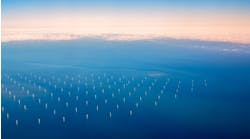The global FLNG market is revving up, spurred on by lower unit costs, standardized designs, and growing demand for quick-to-market LNG supply.
The FLNG market and its relevant technologies will be the focus of a session at Gastech 2024 on Wednesday morning at 10 am, with speakers scheduled from GTT, Exmar Marine NV, and Wison New Energies.
Much of the focus of the presentations will no doubt be on Africa, which has become the epicenter of FLNG projects. That continent should account for 56% (10.2 mmpta) of capacity onstream during the 2023-27 period, says Westwood Global Energy Group.
In recent years, resource-rich African markets have faced challenges developing gas for export, including from armed insurgency and infrastructure sabotage. FLNG is removed from these above-ground risks. It also provides African producers with an alternative to supplying the domestic market. Use of FLNG units to develop large gas reserves offshore Mauritania, Senegal, Tanzania and Mozambique is also seen as a lesser security risk to IOCs than local onshore alternatives.
Over the past year, experienced FLNG developers Eni and Perenco have sanctioned a two-phase floating development in Congo and a barge-based project in Gabon, respectively. But new entrants, such as UTM offshore and NNPC, are also considering FLNG to develop Nigeria’s stranded offshore volumes. In East Africa, FLNG continues to be linked as a potential development option for the Rovuma partners.
Other African FLNG projects set to be sanctioned in the coming years likely include a second unit at Eni’s Area 4 development offshore Mozambique and other(s) for bp’s Yakaar-Teranga and BirAllah gas discoveries offshore Senegal and Mauritania.
Meanwhile, other African FLNG projects have recently started production operations, or will do so soon. The FLNG Gimi vessel has reached the Greater Tortue Ahmeyim (GTA) field location offshore Mauritania and Senegal following a voyage from the Seatrium conversion yard in Singapore. Upon completion of preparatory activities, the vessel will be directed to its berth at the projects’ hub for subsequent connection to the offshore gas pipeline. The vessel is due to operate on the GTA field for the next 20 years.
Elsewhere, Eni has introduced first gas to the Tango FLNG vessel moored offshore Congo, 12 months after taking FID on the Congo LNG project. Tango FLNG has a liquefaction capacity of close to 1 bcm/yr and is moored alongside the Excalibur floating storage unit via a split mooring configuration. Congo LNG will monetize gas resources from the Marine XII permit and reach around 4.5 bcm/yr of plateau gas liquefaction capacity under a phased development, with a target of zero routine gas flaring. A second FLNG facility (3.5 bcm/r capacity) is under construction and should start production for Eni in 2025.
Still elsewhere, Wison New Energies says that it has started the design validation and early engineering studies for two FLNG projects owned by Nigerian companies Ace Gas and FLNG and Transoceanic Gas & Power. In January, Wison reported that it had launched the pre-FEED phase for two 3 million tons per annum (mtpa) FLNG vessels under a “design one and build two” strategy. Transoceanic’s FLNG project is located offshore Pennington and proximal to OML 289, a block operated by the company on behalf of Cleanwaters consortium. It is designed to supply 3 mtpa of LNG to the international market, and 150,000 metric tons per year (MT/yr) of LPG to the domestic market. As part of the phased development plan, the project will deploy a floating power barge concept, starting with a Phase 1 Power capacity of 250MW.
The Ace Gas and FLNG project is located offshore Escravos and is also designed to supply 3 mtpa of LNG to the international market, and 150,000 MT/yr of LPG to the domestic market.
Editor’s note: For further details on the growing FLNG market, please see the FLNG feature article which appeared in the March-April 2024 issue of Offshore magazine.




